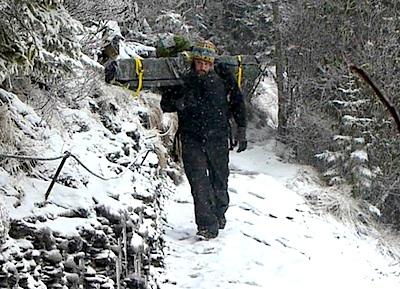Seasons in the Smokies, the second in the Smoky Mountain Explorer Series from Great Smoky Mountains Association, will make its first appearance on the big screen during a premiere showing of the film Thursday, July 17.
Gary Wilson, GSMA's award-winning filmmaker, will discuss what it took to make this project during an hour-long exclusive premiere event at Sugarlands Visitor Center near Gatlinburg, Tennessee, beginning at 4:30 p.m. on July 17.
Wilson spent countless hours hiking in Great Smoky Mountain National Park's backcountry, filming, editing and writing to produce a film that takes viewers effortlessly through the calendar from a frigid winter high atop Mt. Le Conte to a balmy summer day in Cades Cove to the stunning fall landscape seen everywhere in the Smokies each October.

Great Smoky Mountains Association cinematographer Gary Wilson hikes to Mt. Le Conte during a winter storm to capture footage of the area rarely seen by others/GSMA.
'Gary's willingness to carry his substantial equipment six or seven miles up a steep mountain trail and climb out of his sleeping bag at 3:30 a.m. to shoot time lapses of sunrise sets his images apart,' said Steve Kemp, GSMA's interpretive products and services director.
Wilson has visited some 33 different national parks and spent thousands of hours filming and photographing the backcountry. His first full-length film project for GSMA's Explorer Series, An Island in the Sky, took first-place honors at the most recent Association of Partners for Public Lands media competition. Since its release last summer, the DVD/BluRay has raised thousands of dollars to support park projects.
'Having visited national parks in the west like Yosemite, Mount Rainier and Glacier, I know firsthand that they are renowned for open fields of wildflowers with iconic mountain views,' said Wilson. 'Yet, the Great Smoky Mountains have their own iconic views with flowering plants on heath balds that hug some of the park's most rugged terrain. That's just a small part of what I wanted to show with this film.'
The Thursday, July 17, viewing of Seasons of the Smokies is open to the public free of charge. Following his talk, Wilson will be available to autograph copies of both his Smoky Mountain Explorer films.
Since its inception in 1953, Great Smoky Mountains Association has supported the preservation of Great Smoky Mountains National Park and by promoting greater public understanding and appreciation through education, interpretation and research. A non-profit organization, GSMA has provided more than $32 million to the park during its 60-year history. Funds generated through sales of Seasons of the Smokies support the national park.



Comments
Thanks Kurt. I appreciate you posting this. I won't say anything more...
John, just for the record, I do follow park rules and regulations in regards to filming. Every time i'm in the backcountry, I have my backcountry permit that i've purchased, and also meet the requirements as a single filmmaker in regards to carrying 2 tripods, minimal sound equipment, and DSLR's. Also, not once in 3 years have I been sited, or scorned by a ranger for any of my countless hours spent in the field, and i've encountered quite a few of them. I also follow ethical guidelines to a T when I film wildlife.. You claim that you walk around trails, picking up trash? Well, so do I. I've done quite a bit of that over the years. I've hauled out a lot of trash and debris over the years at shelters and campsites, and on trail.
I've also talked to and pointed many of visitors to having a great adventure in the park, by giving them information on what's in bloom, best places to go to see wildlife, or what trails are good at what time of year.
So your continual attempts at bullying me, and everyone that either is part of a cooperating association, or within any part of a National Park is a bit of a joke. Unlike you i'm part of an organization that helps fund the park.
Gary, your obviously a talented film maker. I can't help but wonder where all of your anger comes from. Respecting Kurt's wishes I will refrain from further comments. However, somehow would like to talk to you offline. Lastly, as a SFWer I have always followed the rules (always have my permit), support the park, hauled out my share of trash, and as you put it have never been scorned by a ranger.
Buxton is referring to a specific group fighting for reasonable access to CHNSRA that holds several beach clean ups per year. Something the NPS does not do, and the result is the VFAs have more trash then the ORV areas. The OBX Group NPS has had to be shamed into doing any cleaning up. A recent example is where they put a prenesting closure, which was feet away from a highway, and cleaned up the trash inside the closure but left all the other trash strewn all along the highway in the same area. I am sure they were too busy erecting all those closure signs...
Beachdumb
Not sure how the Park not cleaning up trash in the state highway easement is necessarily the NPS responsibility. We have a very different definition of reasonable access and no I wasn't thinking just about ORVs in Hatteras. I was also thinking of articles about snowmobiles, rafting, mountain biking, base jumping etc. I am sure others have examples. I think it is great your ORV organizations clean up their beaches just saying i dont need a vehicle or feel the need to validate my trash efforts. The question I was exploring is what is good stewardship? And I think Gary's work is an excellent example.
Can we discuss that?
Not my organiziation and not a member, but I have donated to them and others in the past via collection coin jars and BBQ fund raisers. I agree that stewardship can not be judged solely on who picks up the most trash.